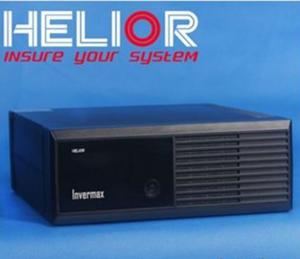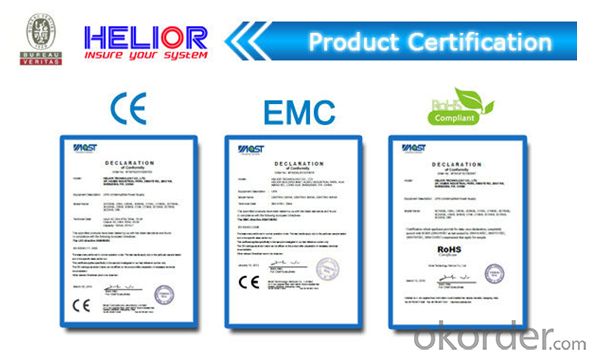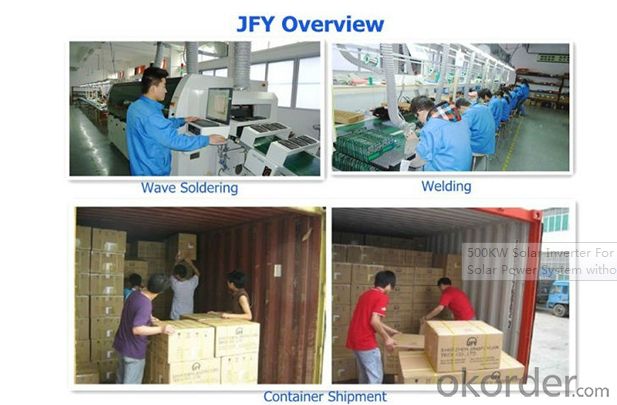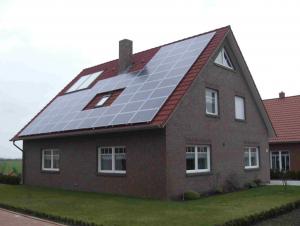Solar Inverter Suppliers - Best MPPT Inverter Hybrid A
- Loading Port:
- Shanghai
- Payment Terms:
- TT or LC
- Min Order Qty:
- 15 unit
- Supply Capability:
- 1000 unit/month
OKorder Service Pledge
OKorder Financial Service
You Might Also Like
1. Structure of Solar Inverter, Best Mppt Inverter Hybrid A Description
A solar inverter, or PV inverter, or Solar converter, converts the variable direct current (DC) output of a photovoltaic (PV) solar panel into a
utility frequency alternating current (AC) that can be fed into a commercial electrical grid or used by a local, off-grid electrical network. It is a
critical BOS–component in a photovoltaic system, allowing the use of ordinary AC-powered equipment. Solar inverters have special
functions adapted for use with photovoltaic arrays, including maximum power point tracking and anti-islanding protection.
2. Main Features of Solar Inverter, Best Mppt Inverter Hybrid A
• High Frequency inverter
• Rack Tower Design
• Off mode charging inverter
• Full automatic and silent operation
• User selectable for accepting wider input voltage
• Compact size for convenient use and storage
• Built-in 8Amp super charger for up to 100Ah battery
• Small Scale and cost effective inverter for home appliances and office equipment
• Two-steps intelligent charging control to reduce the recharging time
3. Power Inverter with Solar Inverter, Best Mppt Inverter Hybrid A Images
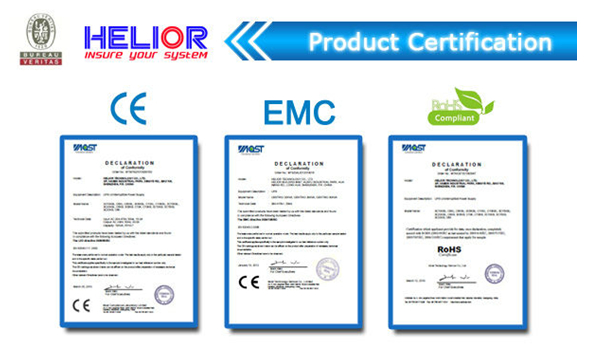

4. Solar Inverter, Best Mppt Inverter Hybrid A Specification
窗体顶端 MODEL窗体底端 |
| INVERMAX 500 | INVERMAX 1000 | INVERMAX 2000 |
CAPACITY | VA/W | 500VA / 300W | 1000VA / 600W | 2000VA / 1280W |
INPUT | Phase | Single | ||
Voltage | 110 / 120VAC or 220 / 230 / 240VAC | |||
Voltage Range | 90 - 145VAC or 170-280VAC ( Narrow Range ) | |||
50-145VAC / 90-280VAC (Wide Range) | ||||
OUTPUT | Phase | Single | ||
Voltage | 120VAC or 230VAC | |||
Voltage Regulation(Batt. Mode) | -0.555555556 | |||
Frequency | 50Hz or 60Hz | |||
Frequency Regulation (Batt. Mode) | +/- 0.1 Hz | |||
Output Waveform (Batt. Mode) | Modified Sinewave | |||
POWER FACTOR | P.F. | 0.6 | ||
BATTERY | Charger Current | 8 Amp + / - 1Amp | 6 Amp + / - 1Amp | 10 Amp + / - 1Amp |
Floating Voltage | 13.7V + / - 0.2V | 27.4V + / - 0.4V | ||
Overcharge Protection | 14.5V +/- 0.3V charger stops and fault | 29V +/- 0.6V charger stops and fault | ||
TRANSFER TIME | Typical | 8ms (Narrow mode) | ||
EFFICIENCY | AC to AC | >95% | ||
DC to AC | >80% | |||
INDICATOR | AC Mode | Green LED lighting | ||
Battery Mode | Yellow LED lighting | |||
Battery Charging Mode | Green LED flashing every 2 seconds | |||
Overload | Red LED flashing every 0.5 second | |||
Fault | Red LED lighting | |||
AUDIBLE ALARM | Low Battery at Battery Mode | Sounding every 2 seconds | ||
Overload | Sounding every 0.5 second | |||
Fault | Continuously sounding | |||
PROTECTION | Full Protection | Deep Discharge, Overcharge, Overload protection, Short Circuit, Battery Shot, Over Voltage and Under Voltage | ||
PHYSICAL | Dimension (DxWxH) mm | 224 X 255 X 80 | ||
Net Weight (kgs) | 1.7 for 500VA / 300W | 2.5 | ||
ENVIRONMENT | Operating Environment | 0~40 Degrees Centigrade, 0~90% relative humidity (non-condensing) | 0~50 Degrees Centigrade | |
Noise Level | Less than 45dB 窗体底端 | |||
5. FAQ of Solar Inverter, Best Mppt Inverter Hybrid A
Q1:Can we visit your factory?
A1:Sure,welcome at any time,seeing is believing.
Q2:Which payment terms can you accept?
A2:T/T,L/C,Moneygram,Paypal are available for us.
- Q: Can a solar inverter be used with solar-powered water pumps?
- Yes, a solar inverter can be used with solar-powered water pumps. A solar inverter converts the DC power generated by solar panels into AC power, which is suitable for running various electrical devices, including water pumps. This allows the solar panels to directly power the water pump, enabling it to operate efficiently using renewable energy from the sun.
- Q: Can a solar inverter be used with dual-axis solar trackers?
- Yes, a solar inverter can be used with dual-axis solar trackers. A solar inverter is responsible for converting the direct current (DC) generated by the solar panels into alternating current (AC) that can be used to power electrical devices or be fed into the grid. The dual-axis solar trackers enable the solar panels to follow the sun's movement in both horizontal and vertical directions, maximizing their exposure to sunlight throughout the day. The solar inverter can still perform its function of converting DC to AC regardless of the type of solar tracking system used.
- Q: What is the maximum number of AC outputs in a solar inverter?
- The maximum number of AC outputs in a solar inverter varies depending on the model and design of the inverter. Some solar inverters may have a single AC output, while others can have multiple AC outputs, ranging from two to four or even more.
- Q: How does the input voltage rating affect the performance of a solar inverter?
- The input voltage rating is a critical factor in determining the performance of a solar inverter. The inverter's ability to convert the direct current (DC) generated by solar panels into alternating current (AC) for use in homes or businesses depends on the input voltage rating. If the input voltage rating of the inverter is not compatible with the voltage produced by the solar panels, the inverter may not function properly or may even be damaged. Thus, selecting an inverter with the correct input voltage rating is essential for optimal performance and longevity of a solar power system.
- Q: Are there any fire safety concerns associated with solar inverters?
- Solar inverters do pose some fire safety concerns. Although they are not typically a fire hazard themselves, there are a few potential risks to be aware of. Firstly, if the solar inverter is installed incorrectly, it can cause electrical problems that may lead to a fire. To prevent this, it is essential to hire a qualified and certified professional who can ensure that all electrical connections are secure and meet the necessary standards. Secondly, if the solar inverter is located in an area that experiences high temperatures or excessive heat, there is a risk of overheating. Inverters generate heat as they convert direct current (DC) from solar panels into alternating current (AC) for use in homes or businesses. If the inverter is not adequately ventilated or is exposed to extreme heat, it can overheat and potentially ignite a fire. Furthermore, if the inverter is faulty or damaged, it can increase the risk of fire. Regular maintenance and inspections of the solar inverter can help identify any potential issues and ensure its safe operation. To address these fire safety concerns, it is crucial to adhere to proper installation guidelines, regularly inspect and maintain the inverter, and ensure it is in a well-ventilated location away from sources of excessive heat. It is also advisable to have a fire extinguisher nearby and establish a fire safety plan in case of emergencies.
- Q: Can a solar inverter be used with a monitoring system?
- Yes, a solar inverter can be used with a monitoring system. In fact, many solar inverters are equipped with built-in monitoring capabilities, allowing users to track the performance and output of their solar energy system in real-time. Additionally, there are also external monitoring systems available that can be integrated with a solar inverter to provide more advanced monitoring features and data analysis.
- Q: How does a solar inverter handle reactive power?
- A solar inverter handles reactive power by actively managing and controlling the flow of reactive power between the solar panels and the electrical grid. It uses advanced electronics and control algorithms to ensure that the reactive power generated by the solar panels is either supplied to or absorbed from the grid, depending on the grid's requirements. This helps to maintain the power factor within acceptable limits and prevents issues such as voltage instability or flickering.
- Q: How do you choose the right brand of solar inverter?
- When choosing the right brand of solar inverter, it is important to consider factors such as reliability, efficiency, warranty, and compatibility with your specific solar panel system. Researching customer reviews, comparing specifications and features, and consulting with solar professionals can help in making an informed decision.
- Q: Are there any voltage or frequency regulations for solar inverters?
- Yes, there are voltage and frequency regulations for solar inverters. These regulations vary from country to country and are typically set by regulatory bodies or standardization organizations. In most countries, solar inverters must comply with specific voltage and frequency limits to ensure the safe and reliable operation of the electrical grid. Voltage regulations specify the allowable range of output voltage that a solar inverter can provide to the grid. This ensures that the voltage remains within acceptable limits to prevent overvoltage or undervoltage conditions that could damage electrical equipment or disrupt the grid's stability. The specific voltage limits depend on factors such as the type of grid system (e.g., single-phase or three-phase) and the voltage levels used in the country. Frequency regulations, on the other hand, define the acceptable range of output frequency that a solar inverter can provide to the grid. Grid frequency is typically set at a specific value (e.g., 50 Hz or 60 Hz) and solar inverters must synchronize their output frequency with the grid to ensure compatibility. Deviations from the specified frequency can lead to issues such as equipment malfunction or instability in the grid. Compliance with voltage and frequency regulations is crucial for solar inverters to ensure the proper integration of renewable energy sources into the electrical grid. In many countries, solar inverters must adhere to specific technical standards or certifications to demonstrate their compliance with these regulations. These standards often cover various aspects of inverter performance, including voltage and frequency control, power quality, and grid interaction.
- Q: What is the role of a solar inverter in a solar-powered desalination system?
- The role of a solar inverter in a solar-powered desalination system is to convert the direct current (DC) electricity generated by the solar panels into alternating current (AC) electricity that can be used to power the desalination equipment. The inverter ensures efficient and safe power conversion, allowing the system to effectively utilize the energy generated by the solar panels for the desalination process.
Send your message to us
Solar Inverter Suppliers - Best MPPT Inverter Hybrid A
- Loading Port:
- Shanghai
- Payment Terms:
- TT or LC
- Min Order Qty:
- 15 unit
- Supply Capability:
- 1000 unit/month
OKorder Service Pledge
OKorder Financial Service
Similar products
Hot products
Hot Searches
Related keywords
